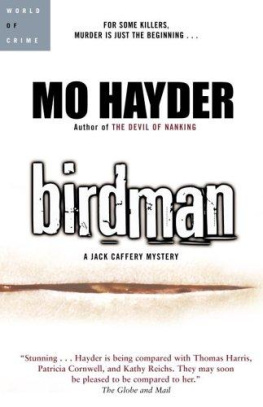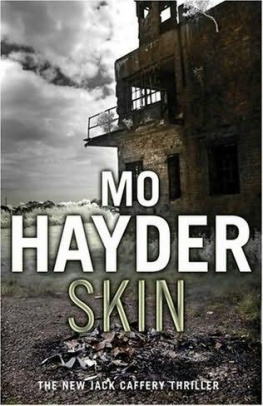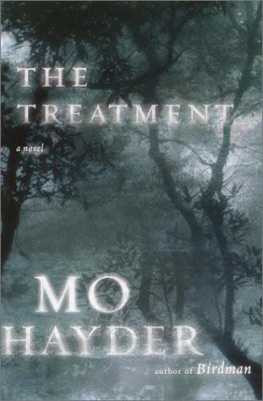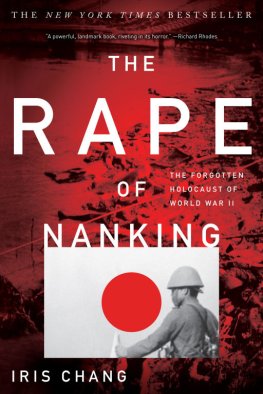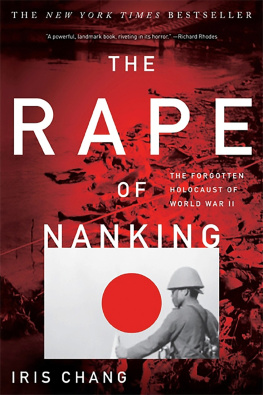THE DEVILOF NANKINGMo HayderLONDON TORONTO SYDNEY AUCKLAND JOHANNESBURG
Table of Contents
About the Author
After leaving school at fifteen, Mo Hayder worked as a barmaid, security guard, film-maker, hostess in a Tokyo club, educational administrator and teacher of English as a foreign language in Asia. She also has an MA in creative writing from Bath Spa University.
Visit www.mohayder.net
for more info and join the forum.
Authors Note
In 1937, four years before the USA was drawn into the Pacific war with the attack on Pearl Harbor, Japanese forces advanced into mainland China and stormed the capital, Nanking. The events that followed exceeded every Chinese citizens worst fears, as the invading army embarked on a month-long frenzy of rape, torture and mutilation.
What prompted an otherwise disciplined army to behave in this way has been long debated (for an excellent exploration of the Japanese soldiers psyche, see Ruth Benedicts classic The Chrysanthemum and the Sword). But perhaps the most contentious issue concerns the numbers of casualties involved. Some in China say as many as four hundred thousand died that winter; some in Japan insist it was no more than a handful. History, we are repeatedly reminded, is written by the victors, but history is rewritten by many other parties: revisionists; politicians; fame-hungry academics; and even to some degree the Americans who sought to mollify Japan, recognizing in its geographical position a strategic advantage in the fight against communism. History can change like a chameleon, reflecting back the answer required of it: and with every concerned agency claiming something different, there may be little hope of ever finding an internationally agreed casualty tally.
In a partially opened mass grave at the official Jiangdongmen memorial site, visitors to Nanking can inspect the mingled remains of unidentified citizens killed in the 1937 invasion. Looking at these bones, attempting to appreciate the real extent of the massacre, it struck me that, whatever the true number of casualties, however great or small, four hundred thousand or ten, each of those unremembered and uncelebrated citizens deserves our recognition for what they represent: the large tragedy of the small human life.
Evidence of the massacre has come down to us in fragments: witness reports, photographs, a few feet of blurred 16mm film shot by the Reverend John Magee. Shi Chongmings film is fictional, but it is entirely possible that more footage does exist and has not surfaced for fear of reprisals from Japanese holocaust deniers certainly a print of Magees film, which was taken by a civilian to Japan with the intention of distributing it, quickly and mysteriously disappeared without trace. Given this scattered and anecdotal evidence, it is no easy task, when building a fictionalized account of the massacre, to steer a course between the sensationalists and the obfuscators. For a steadying hand in this matter I relied extensively on the work of two people: Iris Chang, whose book The Rape of Nanking was the first serious attempt to alert a wider public to the massacre, and perhaps even more importantly, Katsuichi Honda.
Honda, a Japanese journalist, has been working since 1971 to bring the truth to his sceptical nation. In spite of the fact that there has been a recent sea change in the Japanese appreciation of their past the Nanking invasion has been cautiously reintroduced to the school curriculum, and no one who witnessed the event will forget the shocked and baffled tears of middle-aged Japanese parents learning the truth from their children Honda Katsuichi nevertheless lives anonymously for fear of right-wing attacks. His 1999 collection of testimonies The Nanjing Massacre contains several witness accounts of the corpse mountain somewhere in the region of Tiger Mountain, including the living human column attempting to climb to safety on thin air. It also contains an almost unbearable first-hand account of an unborn child being cut from its mothers womb by a Japanese officer.
In addition to Hondas work, I also plundered the scholarship of the following: John Blake; Annie Blunt of the Bright Futures Mental Health Foundation; Jim Breen at Monash University (whose excellent kanji database can be found at csse.monash.edu.au); Nick Burton; John Dower (Embracing Defeat); George Forty (Japanese Army Handbook); Hiro Hitomi; Hiroaki Kobayashi; Alistair Morrison; Chigusa Ogino; Anna Valdinger; and all at the British Council, Tokyo. Any remaining errors I claim as my own.
Thank you to the city of Tokyo for permitting me to tinker with its remarkable geography, also to Selina Walker and Broo Doherty, for their faith and energy. The usual resounding howl of gratitude goes out to: Linda and Laura Downing; Jane Gregory; Patrick Janson-Smith; Margaret O.W.O. Murphy; Lisanne Radice; Gilly Vaulkhard. A special smile to Mairi the great. And most of all, thank you to my constants, the best constants a heart could hope for: Keith and Lotte Quinn.
For the sake of clarity all Japanese names have been presented according to the Western tradition: personal name followed by family name. Chinese names, however, are represented traditionally, the family name preceding the personal. Chinese names and terms have been mostly transcribed in the official pinyin system of the Peoples Republic of China. Exceptions are names or terms that are well known in the West in their Wade-Giles form. These include (with pinyin in brackets) the Daoist classic the I-Ching (Yijing), Sun Yat-sen (Sun Yixian), the Kuomintang (Guomindang), the Yangtze (Yangzi), Chiang Kai-shek (Jiang Jieshi), and most importantly the city of Nanking as it was known in the 1930s, now known in pinyin as Nanjing.
BY MO HAYDER
THE DEVIL OF NANKING
Desperate and alone in an alien city, student Grey Hutchins accepts a job as a hostess in an exclusive gentlemens club. There she meets an ancient gangster rumoured to rely on a strange elixir for his continued health; it is an elixir others want at any price...
Left me stunned and haunted. This is writing of breathtaking power and poetry Tess Gerritsen
PIG ISLAND
When journalist Joe Oakes visits a secretive religious community on a remote Scottish island, he is forced to question the nature of evil and whether he might be responsible for the terrible crime about to unfold.
The most terrifying thriller youll read all year Karin Slaughter
BIRDMAN
Greenwich, south-east London. Detective Inspector Jack Caffery is called to one of the most gruesome crime scenes he has ever seen. Five young women have been murdered and it is only a matter of time before the killer strikes again...
A first-class shocker Guardian
THE TREATMENT
Traumatic memories are wakened for DI Jack Caffery when a husband and wife are discovered, imprisoned in their own home. They are both near death. But worse is to come: their young son is missing...
Genuinely frightening Sunday Times
RITUAL
Recently arrived from London, DI Jack Caffery is now part of Bristols Major Crime Investigation Unit. Soon hes looking for a missing boy a search that leads him to a more terrifying place than anything he has known before.
Intensely enthralling Observer
SKIN
When the decomposed body of a young woman is found near railway tracks just outside Bristol, all indications are that shes committed suicide. But DI Jack Caffery is not so sure he is on the trail of someone predatory, and for the first time in a very long time he feels scared.
Hayder is the closest weve got to Stephen King... the goriest thriller writer this side of the pond


